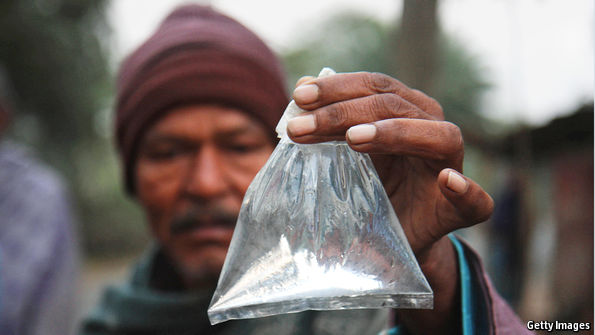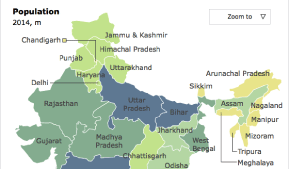India’s governments struggle with their addiction to booze
 Blind faith needed
Blind faith needed
IN LUCKNOW they call it “evening medicine”. In Bangalore the slang is “oil”. Among tamils it is “water”. The Indian government is less poetic. It classes the stuff as IFL, IMFL or IML, terms that stand for imported foreign liquor, Indian-made foreign liquor and Indian-made liquor. But in all its many layers the Indian government remains just as addicted to, and sometimes just as confused by, the demon alcohol as any wine-drenched Urdu bard.
Most Indians do not drink at all, and per person Indians are far more abstemious than others elsewhere (see chart). Yet those who do drink show a preference for the strong stuff. By fast-growing volume India is the world’s third-biggest consumer of alcohol, and far and away the biggest consumer of whisky. Such IMFL brands as Royal Stag and Officer’s Choice, unknown in other markets, rank among the world’s top ten best-selling whiskies. Even in beer Indians exhibit a taste for the bracing. Draught beers high in alcohol make up four-fifths of the local market.
Governments everywhere tax booze and control its sale, but few do so as heavily or as capriciously as India’s. It is not just that the federal government imposes a tariff of 150% on imported spirits. Local licensing fees and taxes, along with a range of gouging state controls on the alcohol trade, stick consumers with end prices that are often five or six times those at the distillery gate. Granted, cheaper, less palatable alternatives exist to real whisky. In Delhi a plastic 0.6-litre bottle of brown liquid whose wonky label proclaims “Star Deluxe 80 Proof” retails for just 140 rupees, or $2. Unlicensed hooch, widely available in India, costs a fraction of that. Sadly it sometimes also kills or blinds. In 2014, 1,700 Indians died after imbibing toxic home brew—mainly as a result of lethal methanol unwittingly being manufactured rather than ethanol.
India’s 29 states and seven union territories have adopted wildly different approaches to alcohol. In the west prim Gujarat has banned it entirely since 1961. By contrast the little territory of Puducherry on the Coromandel coast earns two-fifths of its revenue from an excise tax on booze. Some states auction wholesale and retail licences, or apportion them to friends of the party in power. Others operate their own monopolies. Tamil Nadu’s state monopoly employs 30,000 people and runs more than 6,000 outlets.
Officially tipplers in Mumbai need a licence to consume alcohol. A lifetime pass costs 1,000 rupees and a day ticket five rupees. In theory failing to have one can incur a five-year jail sentence. In Delhi the minimum legal age is a silly 25. Recently police, at the behest of the national government, raided a municipal official’s home to embarrass the local government with the shock discovery that he owned two bottles more than the 12 allowed by local law.
In a bow to Gandhian austerity, India’s constitution lays down the aim of reducing alcohol consumption. Like America in the 1920s, many Indian states have tried prohibition before abandoning it. The odd thing is that some keep trying. Kerala imposed stiff controls last year, and Bihar plans to do so in April. But Manipur and Mizoram, hill states in the north-east, are giving up their bans. They cite rising criminality, the danger of poisonous hooch, loss of state revenues and an inability to control the flow.
Meanwhile other states are simply seeking better ways to milk India’s passion for drink. Andhra Pradesh, whose 51m people already hand over nearly $2 billion a year in alcohol taxes, recently lowered duties on the cheapest Indian-made alcohol and raised them on higher-end potions. It was a carefully calculated bid to earn more from bigger volumes. Revenues have indeed soared, not only from higher local consumption but also because of a surge of smuggling into neighbouring states. Karnataka, dependent on alcohol for nearly a quarter of state revenue and already struggling to plug smuggling from cheaper Goa, has stiffened border checks to stem this new tide. To the north, the state of Punjab actually slaps higher taxes on alcohol “imports” from the rest of India to protect its own distillers.
Taken together, it is an ungainly mix of prudishness and excess, of tangled laws and hefty profits. It says much about the state of India today. In some sectors of the alcohol industry, order is beginning to prevail. For instance, after years of trying to slash a way through thickets of bureaucracy and vested interests, big multinational firms now manage the bulk of the beer industry. Yet despite promoting the idea of a unified national goods and service tax to replace India’s current plethora of federal and state taxes as a key objective of its reform programme, the government of the prime minister, Narendra Modi, has explicitly stated that alcohol will still be taxed the old way. It is too rich a brew for state governments to give up

No comments:
Post a Comment
Note: Only a member of this blog may post a comment.